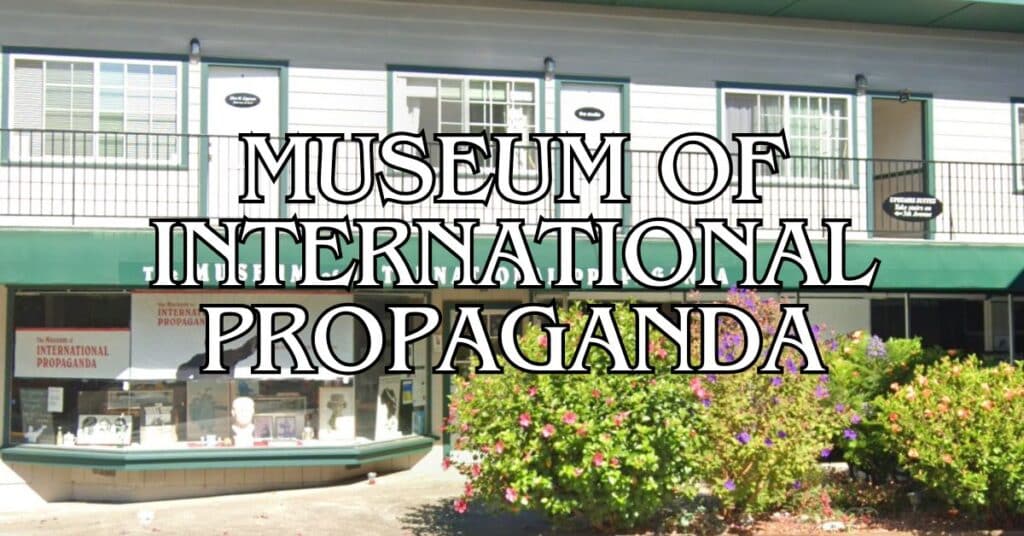Tucked away in Marin County is one of California’s most unique cultural stops—the Museum of International Propaganda. This free museum displays propaganda posters, sculptures, paintings, and artifacts from over a dozen countries. The collection guides you through seven distinct themes and techniques of propaganda, giving you a rare chance to see how governments have tried to shape public opinion through history.
Step inside and you’ll spot everything from vintage Soviet posters to artifacts from China’s Cultural Revolution. Sometimes, special exhibitions highlight events like the Tiananmen Square protests or propaganda from Eastern Europe. What’s wild is that this whole place started as a personal collection by one couple. Over the years, it’s grown into an educational spot you’d be hard-pressed to find anywhere else.
Discover hand-picked hotels and vacation homes tailored for every traveler. Skip booking fees and secure your dream stay today with real-time availability!
Browse Accommodations Now
It’s a small museum, so you can take your time and really soak it in—perfect for a morning or afternoon during your Marin County trip. Wander at your own pace, and you’ll start to notice just how much propaganda has shaped different cultures and eras. The exhibits aren’t preachy; you’re free to draw your own conclusions about what you see.
Overview of the Museum of International Propaganda
The Museum of International Propaganda offers a peek into how governments have pushed their messages through art and media. You’ll see propaganda from all over the world, with a focus on the 20th century and its political movements.
History and Mission
A couple with a passion for political art founded the museum after years of collecting propaganda materials from across the globe. Their private stash eventually became this non-profit museum, dedicated to preserving political art and teaching visitors about propaganda techniques.
They want you to spot propaganda in society, not just in history books. By showing off these artifacts, the museum hopes you’ll become a bit more skeptical of the media messages you run into today.
Admission’s free, so anyone curious about this slice of history can drop in.
Collection Highlights
Instead of sticking to a timeline, the museum organizes exhibits by theme, making it easier to spot the same tricks used by different regimes. You’ll see posters, paintings, sculptures, and plenty of other oddities from over a dozen countries.
Some standout pieces:
- Nazi propaganda from Germany
- Soviet posters
- Chinese Cultural Revolution art
- North Korean promotional materials
- Cuban revolutionary imagery
Seven main themes and techniques run through the exhibits. Some displays even include “action reports” that lay out how propaganda played a role during specific events.
The visuals are bold—sometimes even unsettling—showing how leaders, enemies, and ideologies got spun for mass consumption. It’s eye-opening to realize just how many of these manipulation tactics still pop up in today’s media.
Visiting the Museum in Marin County
If you’re looking for something off the beaten path in Marin County, this museum’s collection of global propaganda is a real find. It’s easy to get to, and the relaxed vibe means you don’t have to rush.
Find the perfect hotel or vacation rental. Instant booking, no fees!
View Top Stays
Location and Hours
You’ll find the Museum of International Propaganda in San Rafael. It’s unassuming from the outside, but inside, the collection spans more than a century of propaganda. Usually, the museum opens around 10:00 AM and closes at 5:00 PM, Tuesday through Sunday. Mondays? Closed for maintenance.
Street parking’s free and easy, and if you’re using public transportation, several bus routes drop you nearby. Schedules can shift for special events, so it’s smart to check their website or give them a call before you go.
Admission and Guided Tours
Admission won’t cost you a dime, which is a nice bonus if you’re into history or political art. The founders really wanted to keep it accessible and open to anyone curious about propaganda’s reach.
Guided tours run a few times a week and give you extra insight into the exhibits. Tours last about 45 minutes, covering the seven main themes and techniques. You don’t have to reserve, but if you’re coming with a group of five or more, it helps to book a guided tour ahead.
Everything’s laid out by theme, not by year. Propaganda from Nazi Germany, the Soviet Union, China, Cuba, and more sits side by side, so you can really see how similar techniques pop up across different systems.
Featured Exhibits and Programs
The Museum of International Propaganda keeps things fresh with a rotating lineup of exhibits and educational programs that spotlight propaganda art from all corners of the globe. There are themed displays, special events, and opportunities to dig into how media messaging works.
International Propaganda Displays
You’ll wander through seven core themes and techniques. Artifacts range from Nazi propaganda cartoons and editions of Der Sturmer to Cultural Revolution-era items from China.
One display that sticks with a lot of visitors? A Nazi ashtray surrounded by other 20th-century political art. It’s a stark reminder of how everyday objects were twisted for political ends.
Placards break down the context and the tricks behind the messaging. Exhibits rotate, and lately, they’ve added:
- Cold War propaganda posters
- Soviet-era artwork
- North Korean political messaging
- World War II recruitment materials
Special Events and Lectures
The museum runs programs year-round to help you dig deeper. Monthly lectures bring in historians and media experts to break down propaganda—old and new.
Every quarter, they screen documentaries, usually followed by a panel where you can throw in your two cents about media literacy. Some recent and upcoming events:
Upcoming Events (Spring 2025):
Luxury stays to cozy cottages await, all with instant booking. Find the best deals!
Browse Marin Stays
- “Decoding Political Messaging” workshop – May 15
- “Propaganda in the Digital Age” lecture – June 2
- “Historical Correspondence: Letters from the Front” exhibit opening – April 30
Guided tours sometimes focus on the founders’ wild journey collecting all these artifacts. School programs are a big deal, too, teaching students how to spot persuasive messaging in the media they see every day.
Global Perspectives and Cultural Connections
Artifacts from over 25 countries fill the Museum of International Propaganda, offering a global look at how art and media have shaped public opinion. The collection is a mix of cultural perspectives and political movements from across continents.
Artifacts from Malaysia, Mali, and Indonesia
Malaysia’s section features posters from the post-colonial period, capturing the country’s push for independence. Leaders used art to unite people from different backgrounds, and you’ll spot some batik-inspired propaganda that blends tradition with politics.
Mali’s artifacts are rare—mostly post-1960 independence pieces. You’ll see how leaders leaned on West African artistic styles to promote unity and development. There are even radio transcripts showing how oral storytelling traditions got pulled into political campaigns.
Indonesia’s propaganda reflects its complicated political past. The museum has posters from Sukarno’s time and the Suharto era, with shadow puppet imagery and batik patterns linking political messages to cultural roots.
Kazakhstan and Central Asian Influence
Kazakhstan’s exhibit takes you through Soviet-era propaganda and how it shifted after independence. Bold posters show a Central Asian style that mixes Soviet visuals with Kazakh motifs.
Some pieces focus on how authorities tried to build a new national identity after the Soviet Union fell apart. You’ll notice nomadic themes, steppe imagery, and industrial development messages all mashed together.
It’s interesting—there are clear links between Kazakh propaganda and that of other Central Asian republics, with shared styles and themes. The museum adds context about Kazakhstan balancing Russian and Chinese influence, offering a nuanced look at the region’s politics.
International Collaborations and Media
Propaganda didn’t stay within borders. The museum highlights cross-border media partnerships and cultural exchanges. One display dives into radio propaganda, with recordings from public radio projects in different countries and their effects on local audiences.
You’ll see materials from collaborations between Eastern Bloc countries and their allies in Africa and Asia. These artifacts show how messaging was tweaked for local cultures but stuck to the same ideological script.
There’s even a section on New Orleans, focusing on American domestic propaganda around disaster response and recovery. It’s a cool comparison to the international stuff, showing some of the same techniques at work.
Interactive media stations let you play around with how propaganda evolved—compare old-school posters to radio, TV, and early internet campaigns. It’s a lot to take in, but you’ll leave with a sharper eye for the tricks behind the message.
Outreach Beyond Marin County
The museum often lends parts of its collection to other institutions, not just in California but far beyond. Lately, some traveling exhibits have made their way to universities, libraries, and cultural centers all over the country.
They’ve put together educational materials that help teachers and students dig into propaganda—both its history and the way it still pops up today. These guides fit state standards but also push folks to think more critically about the media swirling around them.
Virtual tours open up the collection for people who just can’t make the trip. Honestly, it’s kind of wild how these online resources have sparked conversations about propaganda’s impact in places all over the globe.
Sometimes, visiting scholars come by and share their insights through talks or publications. Out of these collaborations, a handful of books and documentaries have come together, exploring how propaganda shifts and changes across different cultures and eras.
Find available hotels and vacation homes instantly. No fees, best rates guaranteed!
Check Availability Now






